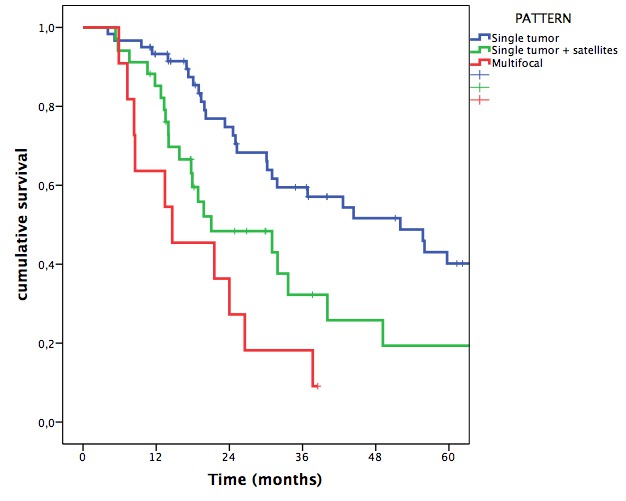|
Back to 2017 Program and Abstracts
SURGERY FOR INTRAHEPATIC CHOLANGIOCARCINOMA WITH MULTIPLES NODULES: COMPARISON OF SINGLE TUMOR, SINGLE TUMOR WITH SATELLITES AND MULTIFOCAL TUMORS
Simone Conci*, Andrea Ruzzenente, Francesca Bertuzzo, Tommaso Campagnaro, Fabio Bagante, Andrea Dore, Calogero Iacono, Alfredo Guglielmi
Department of surgery - University of Verona , General and Hepatobiliary Surgery - G.B. Rossi Hospital, Verona, Italy
Background: The role of surgery in patients with intrahepatic cholangiocarcinoma (ICC) in presence of multiple nodules is still controversial. Although the presence of multiple nodules is included in the T2 stage according to the AJCC staging system, some authors considered it a contraindication for surgery.
Aims: The aims of the study were to compare the clinicopathological features and long-term results of patients with ICC undergoing surgery according to the presence of multiple nodules.
Methods: A retrospective analysis of clinicopathological features of 122 patients with ICC underwent surgery from 1990 to 2015 was carried out. Patients were further classified according to the pattern of presentation in single tumor (type I), single tumor with satellites (multiple nodules within the same liver segment of the main tumor, type II), or multifocal tumors (multiple nodules in another liver segments, type III). We performed a disease specific (DSS) and disease free survival (DFS) analysis on patients underwent surgery with curative intent.
Results: Sixty-six (54.1%) patients presented with type I pattern, 38 (31.1%) with type II and 18 (14.8%) with type III. Curative intent surgery was performed in 90.2% of the patients. Patients with type III pattern showed a higher Ca 19-9 serum level (p=0.001), and poorly differentiation (p=0.048), and a higher rate of palliative/explorative surgery (p<0.001) compare with type I and type II patients. The 5-year DSS and DFS of the patients undergoing curative surgery were 29.9% and 19.0%, respectively. Patterns of presentation resulted a factor significantly related with both DSS and DFS (p<0.001 and p<0.001, respectively). The 5-year DSS of patients with type I, II and III patients were 40.2%, 19.4% and 0.0%, respectively (figure 1). Pattern of presentation, tumor size >50mm, and lymph-node metastasis were independent factors associated with DSS, p=0.001, p=0.047 and p<0.001, respectively. Patients with type I and type II patterns without lymph-node metastases reached a 5-year DSS of 47.5% and 23.5%, respectively.
Conclusion: ICC had three distinct presentation patterns with different prognosis and it should be considered in the therapeutic strategy. Surgery in patients with multifocal ICC should be reserved only for selected cases and after a multidisciplinary discussion.

Back to 2017 Program and Abstracts
|


